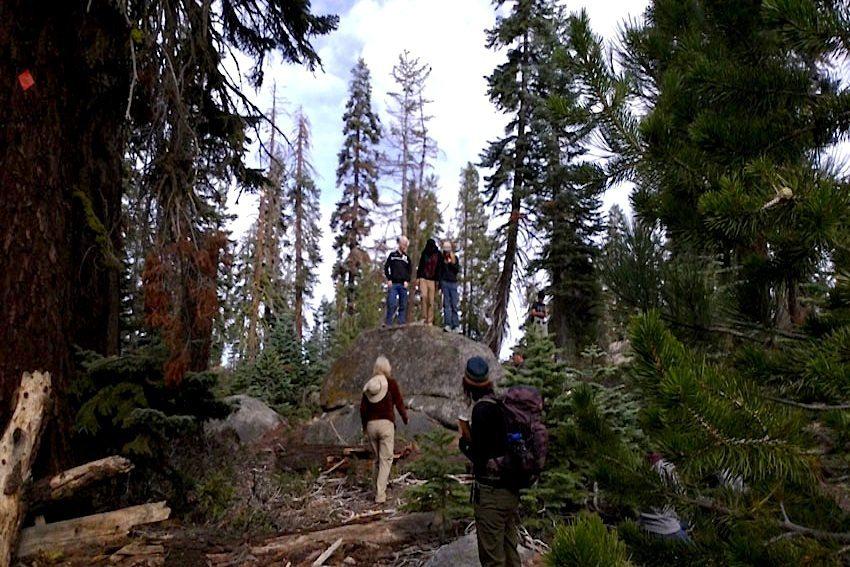

Fresno Christian’s AP biology students tromped through the Sierra Nevada forest this week, gathering data on the world around them. In order to apply the unit of study from the classroom to a real world experience, the students teamed up with UC Merced and Southern Sierra Critical Zone Observatory to run field experiments in the forest.
The class left at 7 a.m. on Oct. 27. Students and teacher Dr. Karen Walters met with UC Merced researchers Lynn Sullivan and Michelle Gilmore before heading to a section of forest up by Shaver Lake. Once there the group assembled their supplies and got to work on the experiment. They aimed to study how the density of trees in an area affects the amount of water in the soil.
Student Olivia Tandadjaja, ’16, who helped measure and record the data on the trip, explains this experiment.
“What we did was trying to find the soil moisture in different plots,” Tanadaja said. “The (amount in soil in) light, the open areas and more dense.”
The process of setting up each experiment involved measuring out a ten by ten meter area in the forest. Students would then identify what trees, if any, were in the plot and count the amount of trees. Students then measured the amount of moisture in the soil with special probes provided by UC Merced, in five sections of the plot. The students recreated this experiment nine times, three times each for areas with dense, moderate, and no tree growth.
Zoe House, ’16, helped record the measurement of water. She says she learned of the effect of density on soil saturation.
“I learned how the density of a certain area in the forest effects the amount of water in the soil,” House said. “There’s so many different factors, like ground cover, that effects how much water ends up in the soil.”
The students hypothesize that the density of trees in an area effect how much water remains in the soil. A prevalent topic in California’s drought, they decided to test it. The hypothesis states that trees growing very close together will drink up all the water from the soil, and no trees causes the sun to evaporate most water, where moderate amounts causes a moderate amount of water return.
We went to give the students real world experience of field research. That opportunity came up because I was just interested in ecology, the unit we were studying. Because of the drought situation and the fire situation, I started looking online researching the topic of water and trees. I contacted UC Merced and said ‘Hey, can we bring students up and do a research project?’ And it turns out yes, they were interested. So Lynn and I put it together. They had an outreach and we had an interest.–Dr. Karen Walters

The AP biology students met with Sullivan previously on campus during class. To prepare them for the field trip, Sullivan and Walters taught the class about the different factors and their consequences on water concentration in soil. The next step took the class on the trip to see what they were taught for themselves. Students appreciated the real-life experience and lesson.
The connection with UC Merced provides students with an idea of what pursuing biology in college might be like. A connection with the UC also provides students with more college experience and an idea of whether they would want to attend a UC for their studies. Walters explained how the class received the opportunity to collaborate.
“We went to give the students real world experience of field research,” Walters said. ” That opportunity came up because I was just interested in ecology, the unit we were studying. Because of the drought situation and the fire situation, I started looking online researching the topic of water and trees. I contacted Dr. Roger C. Bales at UC Merced and said ‘Hey, can we bring students up and do a research project?’ And it turns out yes, they were interested. So Lynn and I put it together. They had an outreach and we had an interest.”
[fusion_soundcloud url=”https://api.soundcloud.com/tracks/230851452″ params=”auto_play=false&hide_related=false&show_comments=true&show_user=true&show_reposts=false&visual=true” width=”100%” height=”150″ iframe=”true” /]
House says this trip forced student to both think outside the box and band together as a scientific team.
“I think doing this develops a hard working ethic because you engage with your classmates and work together as a team, you can’t just stand there,” House said. “You have to be involved, versus at school where you zone out more. It made so much more sense doing it hands-on and was really fun.”
For another features article read Breast Cancer Awareness Month comes to a close, promotes check-ups.